|
Centrip Editorial Board
Shirakawa-go's Must-See Spots: Centrip Japan's Complete Guide to Shirakawa-go

There are two ways to enjoy Shirakawa-go: walk around to see the whole Gassho-zukuri village and look closely at each house. Discover the traditional look of Japan of over hundreds of years.
Ogi-machi Castle Ruin Observation Area
 The Ogimachi Observatory overlooks the whole Gassho-zukuri town. Most of the Shirakawa-go photos that show the entire village are taken here. It is also a popular photo spot to mark the occasion. This observatory was once used as a castle. From the observatory, you can see various seasonal changes of Shirakawa-go. Shuttle buses are available from the village to the observatory, but it is also within walking distance. The observatory closes in the event of heavy snow.
The Ogimachi Observatory overlooks the whole Gassho-zukuri town. Most of the Shirakawa-go photos that show the entire village are taken here. It is also a popular photo spot to mark the occasion. This observatory was once used as a castle. From the observatory, you can see various seasonal changes of Shirakawa-go. Shuttle buses are available from the village to the observatory, but it is also within walking distance. The observatory closes in the event of heavy snow.
Tajima Sericulture Museum
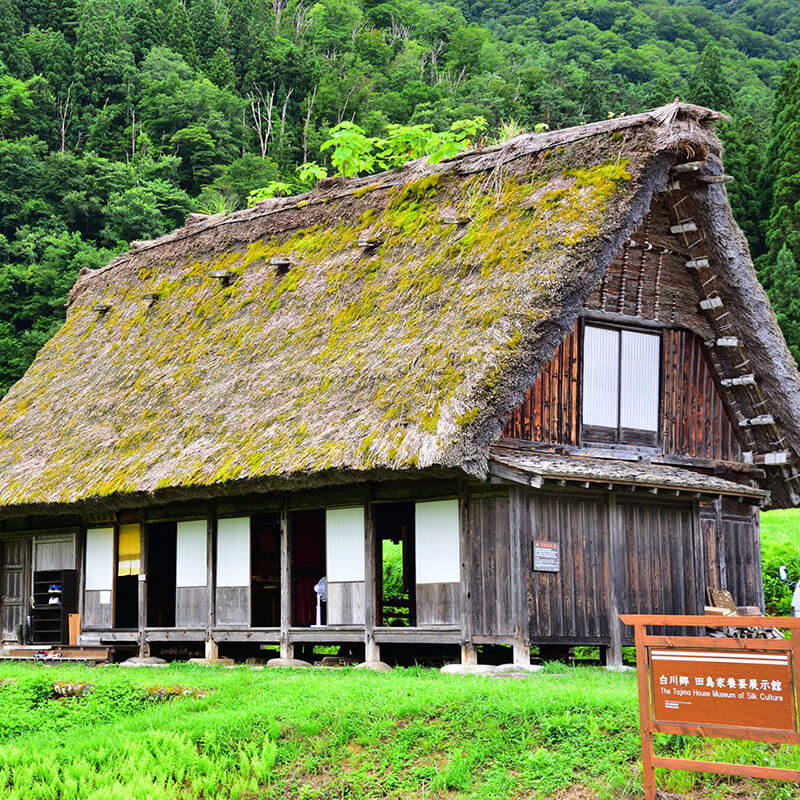 Gassho-zukuri house, Tajima-ke, is now used as an exhibition hall. A long time ago, the attic of this house was used for growing silkworms. They don't grow silkworms anymore though. This is the only place focused on the growing of silkworms in the village. Info about silkworms and signs in foreign languages are available. There is a place to rest here so you can relax and take your time learning about the silkworm industry in Japan.
Gassho-zukuri house, Tajima-ke, is now used as an exhibition hall. A long time ago, the attic of this house was used for growing silkworms. They don't grow silkworms anymore though. This is the only place focused on the growing of silkworms in the village. Info about silkworms and signs in foreign languages are available. There is a place to rest here so you can relax and take your time learning about the silkworm industry in Japan.
Wada House
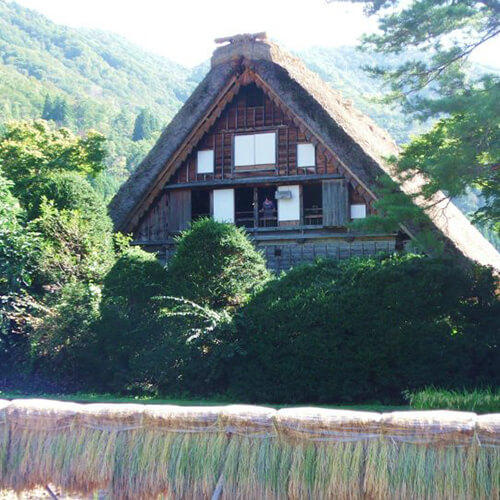 The Wada House is the largest Gassho-zukuri house in Shirakawa-go village. The floor runs 25 meters wide and 13 meters deep and the house has well-preserved gardens and hedges. The rice fields and streams around the house are also kept in a good shape. The main building, storehouses, and toilet are designated as cultural properties. Old tools which have been used here are exhibited so you can imagine the traditional lifestyle of Japan from them. People still live here even after the house was built 300 years ago.
The Wada House is the largest Gassho-zukuri house in Shirakawa-go village. The floor runs 25 meters wide and 13 meters deep and the house has well-preserved gardens and hedges. The rice fields and streams around the house are also kept in a good shape. The main building, storehouses, and toilet are designated as cultural properties. Old tools which have been used here are exhibited so you can imagine the traditional lifestyle of Japan from them. People still live here even after the house was built 300 years ago.
Nagase House
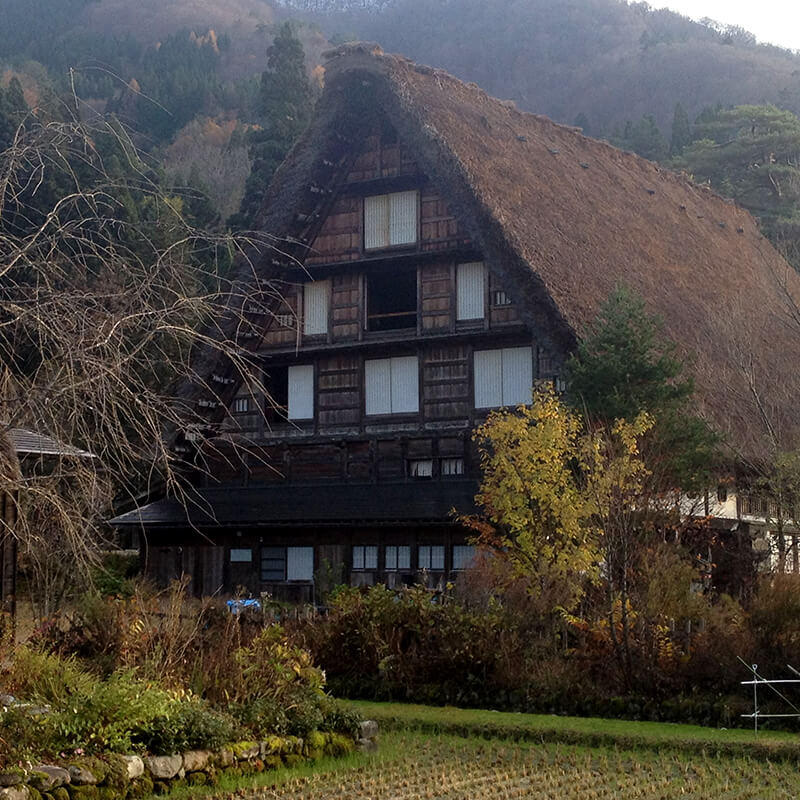 The is a five-story Gassho-zukuri house and an 11-meter tall pillar holds the roof all the way from the top to the bottom. The Nagase House has stood for 250 years. The family here worked as doctors, so there are some medical tools remaining from the Edo period. Don't miss the Buddhist altars and art pieces here. The roof rethatching in 2001 drew attention because it had been 80 years since the previous rethatching. Footage of the rethatching work in 2001 is available.
The is a five-story Gassho-zukuri house and an 11-meter tall pillar holds the roof all the way from the top to the bottom. The Nagase House has stood for 250 years. The family here worked as doctors, so there are some medical tools remaining from the Edo period. Don't miss the Buddhist altars and art pieces here. The roof rethatching in 2001 drew attention because it had been 80 years since the previous rethatching. Footage of the rethatching work in 2001 is available.
Kanda House
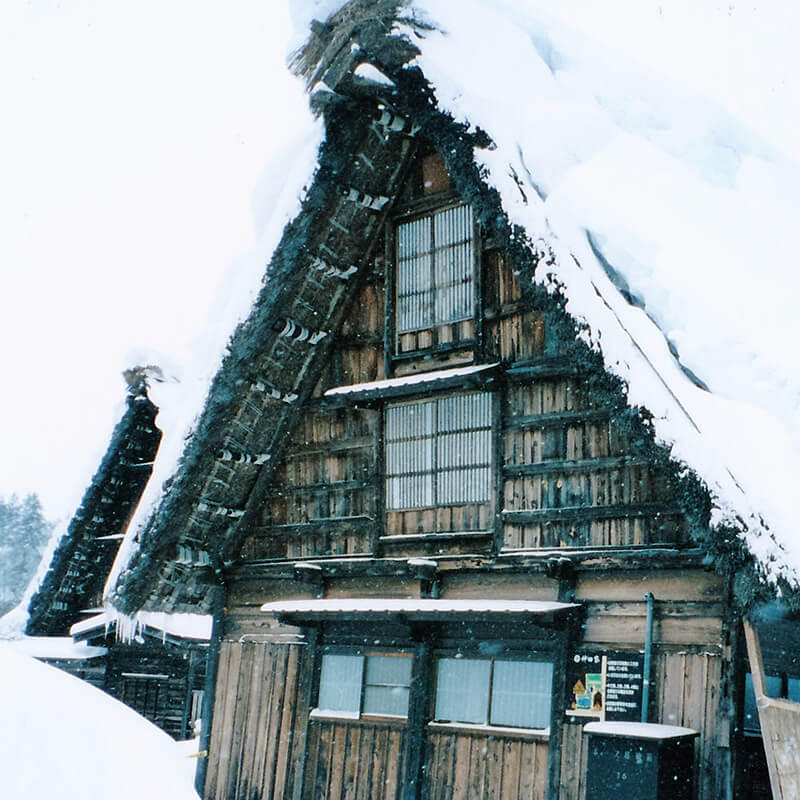 The layout and design of the Kanda House is one of the best among all Gassho-zukuri houses. It was said to have been built around 1850. The stone pavement at the entrance and the main pillar are must-sees. Throughout the year, irori, a cooking hearth built into the floor, is used to serve home-made wild grass tea from the iron pot. Pets are allowed, but you have to carry them in your arms. You can go all the way up to the top of the building.
The layout and design of the Kanda House is one of the best among all Gassho-zukuri houses. It was said to have been built around 1850. The stone pavement at the entrance and the main pillar are must-sees. Throughout the year, irori, a cooking hearth built into the floor, is used to serve home-made wild grass tea from the iron pot. Pets are allowed, but you have to carry them in your arms. You can go all the way up to the top of the building.
Gassho-zukuri Minkaen Outdoor Museum
 This open-air museum is made up of the old Gassho-zukuri buildings which are not used anymore. You can see how people live in a traditional lifestyle. There are 25 Gassho-zukuri houses displayed here, including main houses, shrines, temples, and watermills. At the main house, you can even see the attics. There are also a few buildings built in the 18th century. Rest areas where you can have some tea and relax are available. You may want to try the available hands-on activities such as making soba and straw sandals.
This open-air museum is made up of the old Gassho-zukuri buildings which are not used anymore. You can see how people live in a traditional lifestyle. There are 25 Gassho-zukuri houses displayed here, including main houses, shrines, temples, and watermills. At the main house, you can even see the attics. There are also a few buildings built in the 18th century. Rest areas where you can have some tea and relax are available. You may want to try the available hands-on activities such as making soba and straw sandals.
Shiramizu no Yu
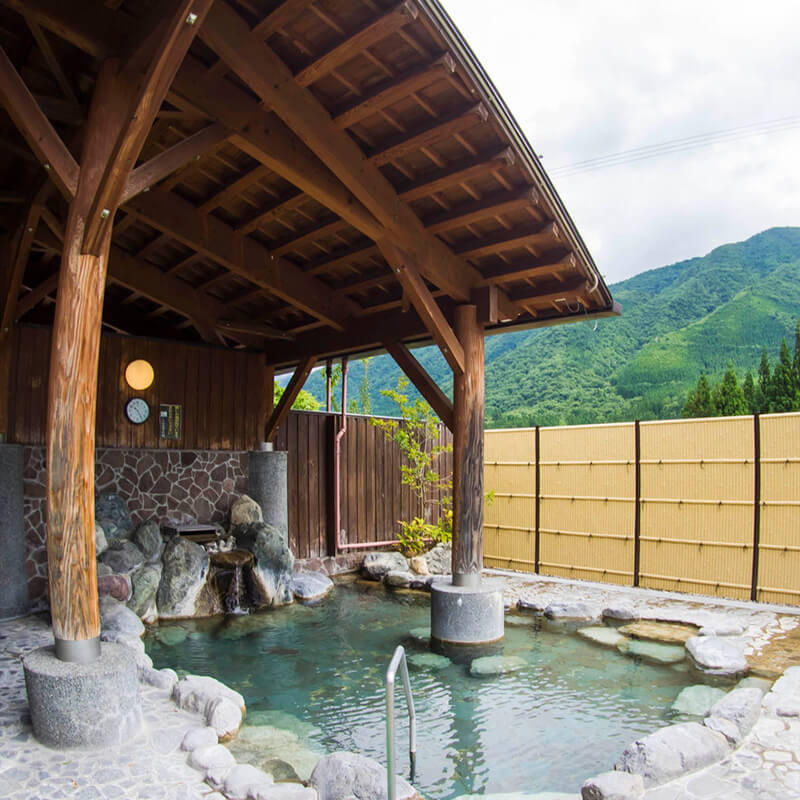 This hot spring water is said to increase fertility AND improve your skin! The water here is 100% naturally-sourced hot spring water and you can take a bath on day trips.
This hot spring water is said to increase fertility AND improve your skin! The water here is 100% naturally-sourced hot spring water and you can take a bath on day trips.
Doburoku Festival museum
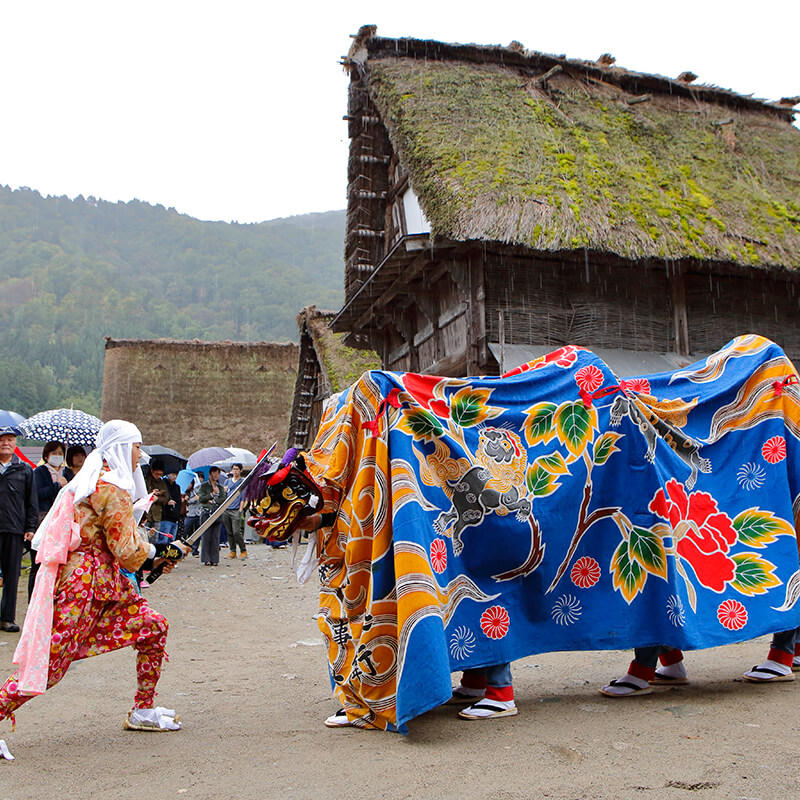 Doburoku is a white-colored fermented sake. In autumn, people dedicate Doburoku to the gods as a token of their gratitude for the harvest and wishes for the peace in their households and the village. You can learn about the Doburoku Festival around town by through dolls and plastic models that are on display. You can try one cup of Doburoku here too. Also, some shrine treasures are displayed.
Doburoku is a white-colored fermented sake. In autumn, people dedicate Doburoku to the gods as a token of their gratitude for the harvest and wishes for the peace in their households and the village. You can learn about the Doburoku Festival around town by through dolls and plastic models that are on display. You can try one cup of Doburoku here too. Also, some shrine treasures are displayed.
Myozenji Museum
 The main place of the temple, the monk's living space, and the bell; everything here is built in Gassho-zukuri style and there's no such place you can find. Shoromon (bell tower gate) is a thatched roof with eaves on the first floor which is also very rare. This is said to be built in 1801 with 1425 people. At Kyodokan (local museum), materials about old tools are displayed. There is a yew tree planted in 1827 for commemoration.
The main place of the temple, the monk's living space, and the bell; everything here is built in Gassho-zukuri style and there's no such place you can find. Shoromon (bell tower gate) is a thatched roof with eaves on the first floor which is also very rare. This is said to be built in 1801 with 1425 people. At Kyodokan (local museum), materials about old tools are displayed. There is a yew tree planted in 1827 for commemoration.
Toyama house
 This four-story houses represent the mainstream architecture of Gassho-zukuri in Shirakawago. It has a solid and heavy-looking exterior. The villager’s food, clothing, and shelter are exhibited. The first floor is a living space, the second floor to the fourth floor is a cocoonery and the basement is for making gunpowder. Long ago, build a house was tough work and people had large families. Try some local cuisines such as ancient rice, tofu, and wild vegetable dishes.
This four-story houses represent the mainstream architecture of Gassho-zukuri in Shirakawago. It has a solid and heavy-looking exterior. The villager’s food, clothing, and shelter are exhibited. The first floor is a living space, the second floor to the fourth floor is a cocoonery and the basement is for making gunpowder. Long ago, build a house was tough work and people had large families. Try some local cuisines such as ancient rice, tofu, and wild vegetable dishes.
Binen-yumeromu Museum
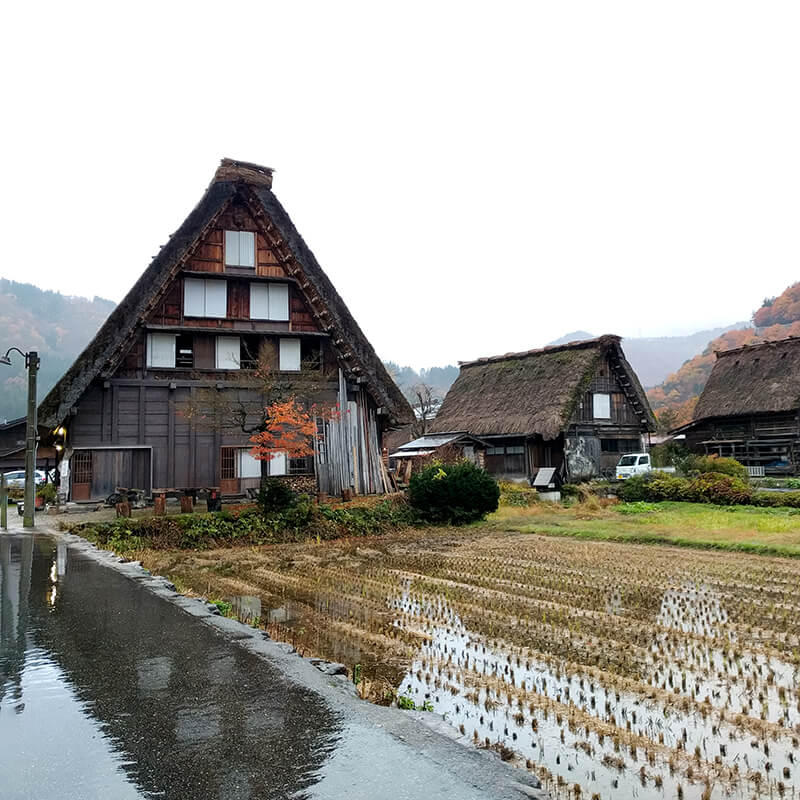 This is a Gassho-zukuri house that was once located in the place called "Mythical Village." A number of masterpieces of Shirakawa-go are exhibited; some of which are Gassho-zukuri paintings by artist, Mr. Itaya, as well as woodcarving works, and woods aged over 800 years. A view inside the building is fantastic and taking pictures are allowed. The mixture of architecture and artwork is overwhelming.
This is a Gassho-zukuri house that was once located in the place called "Mythical Village." A number of masterpieces of Shirakawa-go are exhibited; some of which are Gassho-zukuri paintings by artist, Mr. Itaya, as well as woodcarving works, and woods aged over 800 years. A view inside the building is fantastic and taking pictures are allowed. The mixture of architecture and artwork is overwhelming.
Shirakawago no Yu
 You can take a bath during a day trip, eat and stay in this facility. The hot spring is naturally-sourced. At the open-air bath, you can hear the sound of the stream, see the beautiful mountain ridge in the distance, and Gassho-zukuri houses. You can bathe and eat without staying the night or just have a meal. This is the only hot spring inside of a world heritage sites. There are resting areas where you can relax after bathing. Take a load off.
You can take a bath during a day trip, eat and stay in this facility. The hot spring is naturally-sourced. At the open-air bath, you can hear the sound of the stream, see the beautiful mountain ridge in the distance, and Gassho-zukuri houses. You can bathe and eat without staying the night or just have a meal. This is the only hot spring inside of a world heritage sites. There are resting areas where you can relax after bathing. Take a load off.
Okuzaemon
This is not a Gassho-zukuri, but built in a traditional Japanese style. Pillars and beams from a Gassho-zukuri building were used and it has a modern Japanese interior. The combination of wood and glass is what makes this house so beautiful. Since they used to sell knick-knacks here, you can see the cash registers and lacquered shelves from the Taisho and Showa eras. It's a bit of a trip back to a slightly different. Souvenirs are available for purchase here.Read More
- About Shirakawa-go :Centrip Japan's Complete Guide to Shirakawa-go
- How to enjoy Shirakawa-go :Centrip Japan's Complete Guide to Shirakawa-go
- Trivia for Shirakawa-go sightseeing: Centrip Japan's Complete Guide to Shirakawa-go
- Getting to Shirakawa-go: Centrip Japan's Complete Guide to Shirakawa-go
- Shirakawa-go's Must-Eat Gourmet: Centrip Japan's Complete Guide to Shirakawa-go
- Shirakawa-go Standard Gifts: Centrip Japan's Complete Guide to Shirakawa-go
- Centrip Japan's Complete Guide to Shirakawa-go



